Click on images to enlarge

infestation of Colocasia esculenta var. esculenta (Photo: Chris Gardiner)

habit and leaves of Colocasia esculenta var. esculenta, with green leaf stalks (Photo: Trevor James)

green female flowers below the more numerous yellow male flowers (Photo: Sheldon Navie)
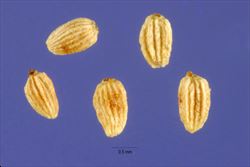
close-up of seeds (Photo: Steve Hurst at USDA PLANTS Database)

infestation of Colocasia esculenta 'Euchlora' along a waterway (Photo: Sheldon Navie)
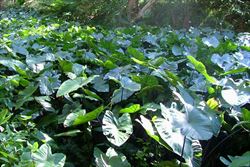
infestation of Colocasia esculenta 'Fontanesii' in Toowong (Photo: Sheldon Navie)
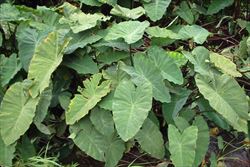
habit and leaves of Colocasia esculenta 'Euchlora', with purplish leaf stalks and slightly bluish-green leaves (Photo: Sheldon Navie)

habit and leaves of Colocasia esculenta 'Fontanesii', with purplish leaf stalks and glossy green leaves (Photo: Sheldon Navie)

tuberous roots and leaf bases of Colocasia esculenta 'Euchlora' (Photo: Sheldon Navie)
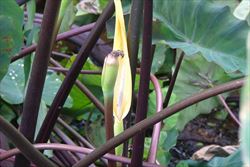
purple leaf stalks, flower cluster and immature fruit of Colocasia esculenta 'Euchlora' (Photo: Sheldon Navie)

glossy green leaf of Colocasia esculenta 'Fontanesii' (Photo: Sheldon Navie)
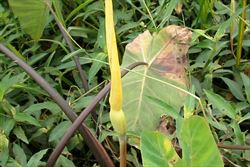
Colocasia esculenta 'Euchlora' leaf, showing how the leaf stalk joins to the leaf underside in this species (Photo: Sheldon Navie)

elongated flower cluster of Colocasia esculenta 'Euchlora' with yellow floral bract (Photo: Sheldon Navie)

the immature fruit of Colocasia esculenta 'Euchlora' are hidden within the remains of the floral bracts (Photo: Sheldon Navie)
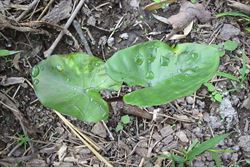
young Colocasia esculenta 'Fontanesii' plant (Photo: Sheldon Navie)

another popular garden cultivar, Colocasia esculenta 'Black Magic', with dark purple older leaves (Photo: Sheldon Navie)
Scientific Name
Colocasia esculenta (L.) Schott
Synonyms
Arum colocasia L.Arum esculentum L.Caladium acre R.Br.Calladium acre R.Br., orth. Var.Caladium esculentum (L.) Vent.Colocasia acris (R.Br.) SchottColocasia antiquorum SchottColocasia antiquorum Schott var. esculenta (L.) SchottColocasia antiquorum Schott var. euchlora (K. Koch & Sello) Schott ex Engl.Colocasia esculenta (L.) Schott var. acris (R.Br.) Schott
Family
Araceae
Common Names
coco yam, cocoyam, dasheen, eddo, elephant ears, elephant's ear, taro, wild taro
Origin
Probably originated in tropical Asia, now widely cultivated and naturalised in the tropical regions of the world.
One wild variety (i.e. Colocasia esculenta var. aquatilis), that has poorly developed tubers, is thought to be native to some parts of northern Australia (i.e. the northern parts of the Northern Territory and northern Western Australia).
Naturalised Distribution
Naturalised in northern and south-eastern Queensland, in south-western Western Australia, and in the coastal districts of central and northern New South Wales. Also naturalised on Lord Howe Island, Norfolk Island and Christmas Island.
Naturalised overseas in southern Europe, southern Africa, La Réunion, New Zealand, south-eastern USA, the Caribbean, Hawaii and several other Pacific islands.
Notes
Taro (Colocasia esculenta ) is regarded as an environmental weed in Queensland, New South Wales and south-western Western Australia. It is of particular concern in south-eastern Queensland, where it invades waterways and wetlands and replaces native aquatic plants. It is listed among the 200 most invasive plants of this region and is also a problem in the coastal districts of New South Wales, north from Wyong. In addition, it is also increasingly becoming a cause for concern along the waterways of the Swan and Moore River catchments in Perth in south-western Western Australia.
Edible cultivars (Colocasia esculenta var. esculenta) and ornamental garden cultivars (mostly Colocasia esculenta var. antiquorum) of this species have been introduced into Australia, and both have become naturalised. However, it is the purple-stalked ornamental garden cultivars (i.e. Colocasia esculenta 'Euchlora' and Colocasia esculenta 'Fontanesii') that seem to be the most invasive in Australia.
Note: these purple-stalked cultivars can be easily confused with blue taro (Xanthosoma violaceum).

